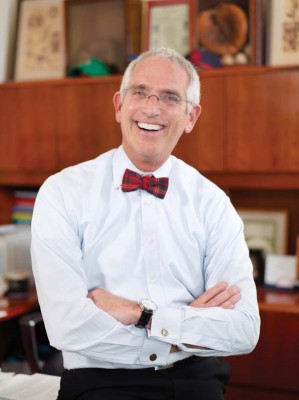
Years in HR: 40
Direct reports: 58
HR INSIGHT: “My vision is to put ourselves out of business. If we are ultimately successful in delivering HR solutions, they become so ingrained in the business and integral to how leaders lead, that a separate function called HR is no longer necessary.”
When CEO Jane Elfers came to The Children’s Place in 2010, the first person she hired was Larry McClure. McClure, senior vice president of human resources—who has held positions at United Technologies Corporation, Aetna, and Liz Claiborne—was brought in to help rebuild North America’s largest children’s specialty apparel brand.
When McClure joined The Children’s Place, the company gave the outward appearance of success: a strong balance sheet, positive cash flow, no debt, and 40–50 new store openings a year. However, the organization lacked capability in three main areas: talent, process, and technology. “In order to rebuild and strengthen the company, we had to start with talent,” McClure explains. “The right talent can identify the technology and process needs we require to stabilize the foundation and then grow.”
To illustrate his point, McClure explains that talent neglect in stores led to turnover of 110–120 percent, which he then traces back to a faulty hiring process: managers were never given the tools to ask applicants if they enjoyed retail sales or helping customers. McClure’s team conducted a survey and discovered that most employees actually didn’t like to sell. Management added a short assessment to the hiring process to determine if an applicant had the orientation and skills to be customer focused. Over the next quarter, The Children’s Place received 100,000 applications for retail positions. Of those, 75,000 either failed the assessment or refused to respond. Suddenly, managers had a better and more customer-focused hiring pool to work with. Turnover dropped to 80 percent in just one year.
Changes continued all the way to the top. The Children’s Place’s entire senior team is new, as is 70 percent of corporate and field staff. With the right team in place, the senior team turned its attention to contemporizing the technology platform to support the company’s growth initiatives. Now, senior executives are working together to launch a business-transformation initiative to mobilize the key stakeholders in the business on the future vision for the company and the technology initiatives needed to realize that vision. McClure sits on the steering committee and has worked hard to make sure HR plays an important role in every regard. “Our philosophy is business first and function second. We want everyone on the HR team to see themselves as more than business partners. They need to show up as business people,” he says, adding that the team’s priority is “making the business successful.”
—Larry McClure
To make the HR structure mirror this credo, McClure embedded three HR executives into specific areas of the business. Each one also owns a company-wide shared-service responsibility, such as recruiting, leadership development, or HR Information System. “This was a signal to the business that we are full participants,” says McClure, noting that he has already seen success with the measure. In one case, for example, an HR executive was selected to step out of her HR function and join the business-transformation team as the leader of the project-management and change-management offices.
A high-performing HR team within a major company must understand all functions. “HR professionals should understand everything that happens in the business, including how to read a P&L and balance sheet or how to understand a daily sales report,” says McClure, advocating that his HR colleagues are only effective when they grasp how all other departments function at the company.
Now, as the company rebuilds, McClure is enjoying buy-in from his colleagues. The Asian operations team, based in Hong Kong, praised his partners for making a bold organization presentation, grounded in an understanding of the sourcing business. And now its common to find HR pros sitting on important teams and committees throughout the company, demonstrating that the notion of HR as an integral part of the business is taking hold. “When HR is done right, it has a huge impact on many areas,” McClure says.
More than three years into his tenure, McClure is working with his team to modernize the development curriculum and the organization’s review process. The logistical challenges of time and location—with over 1,100 stores and offices in faraway locales like Asia—led McClure’s team away from a standard classroom settings in favor of an online model. An online learning and performance support tool through Harvard ManageMentor will allow busy retail employees the chance to build the skills necessary for career advancement in a self-paced environment.
McClure says he has been fortunate to have worked with great leaders in diverse businesses, and credits those experiences with giving him the insight necessary to lead HR at The Children’s Place. At his current job, he asks potential HR applicants two things: to explain whether HR represents management or the employee, and to define the HR function. “I’m not interested in hearing how I would answer these questions,” McClure says. “I want to know if they have a clear point of view and can express a philosophy.”
To that end, McClure encourages people to think of HR as a marketing job. HR teams provide a variety of products and services that a company could get anywhere in the open market. Being inside the business affords HR members an advantage—they understand how the company works and act accordingly with business interests in mind. “All too often, HR is seen as the sweepers at an elephant parade,” says McClure. “If we are marketers, then we are in front of the business, developing the right kind of solutions to get the right kind of talent to deliver the right kind of results.”

